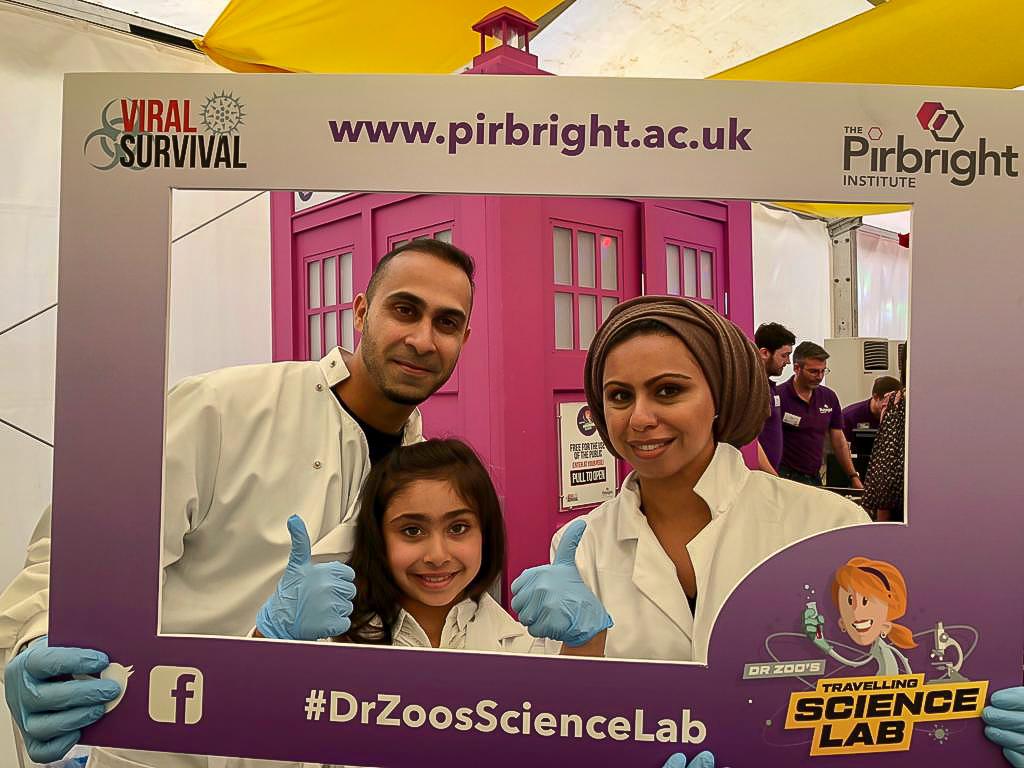The Pirbright Institute returned as a festival sponsor to Cheltenham Science Festival between 7 and 9 June 2019. Pirbright’s theme this year was ‘Viral Survival’, which centred on diseases that can spread from animals to people, called zoonoses, and how Pirbright scientists are working on different strategies to predict and prevent pandemics.
Pirbright could be found in the Discover Zone showcasing a series of activities that required visitors to crack codes and solve puzzles while working against the clock, much as scientists might have to do during an outbreak of a deadly new unknown virus. The star of the show was the hugely popular Dr Zoo’s Travelling Science Lab, an eye-catching pink Tardis-inspired mini-escape room. Visitors queued up for the chance to escape a deadly virus by putting on protective clothing, entering the sealed box and solving a series of science clues to escape in under five minutes. Over 508 people were brave enough to have a go and the fastest recorded escape time was an amazing 2 minutes and 17 seconds.
Alongside Dr Zoo’s lab children and adults alike were able to build a flu virus and tackle a containment box in which a ‘field sample’ from the outbreak could be ‘analysed’ by completing several puzzles, as well as talk to scientists about the research they carry out at Pirbright.
Pirbright also hosted two exciting ‘Viral Survival’ Escape Room sessions, on Sunday 9 June in The Pillar Room in Cheltenham Town Hall. In this interactive science lab participants had to work their way through four zones – Virus Zone, Vaccine Zone, Containment Zone, Contagion Zone – against the clock in order to survive a virus causing a deadly disease outbreak. The participants were divided into groups of ten and with just ten minutes to complete each zone team members had to work together to explore the zones, crack puzzles, and solve clues to deduce which virus was the cause of the outbreak and ‘survive’.
Participants donned hazmat suits, delved into bodily fluids and entered a virtual cell while host ‘Dr Zoo’ (Karl Byrne) encouraged, cajoled and kept them on track. Four out of the seven teams that participated managed to identify the correct virus as Crimean-Congo haemorrhagic fever (CCHF), a deadly disease of cattle, sheep and goats spread by ticks that can also infect humans. While not everyone managed to ‘survive’ the event captured people’s imagination and was enjoyed by all.
On Friday 7 June, Dr Dalan Bailey and Dr Simon Gubbins were joined by international flu expert Professor Wendy Barclay and broadcaster Vivienne Parry for Pirbright’s panel discussion ‘Predicting Pandemics’. The event tackled the big questions about how pandemics spread across the globe, and how Pirbright scientists use different tools to predict and prevent their spread. The talk particularly focussed on zoonoses, outlining the World Health Organization’s blueprint list of priority diseases and how research on these emerging diseases is important for both human and animal health. The audience was extremely engaged and had many questions to ask.
Helping the public understand more about the viruses scientists study is an extremely important element of the research undertaken at Pirbright. Feedback received from the event so far shows Pirbright is achieving its goal to help inform and engage the public on its research in a novel, challenging and entertaining way.
